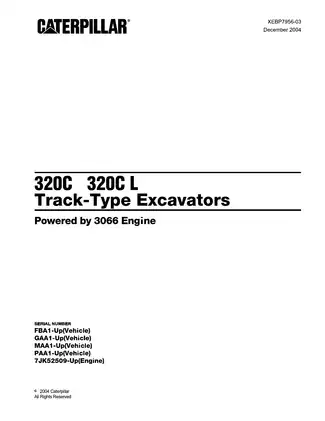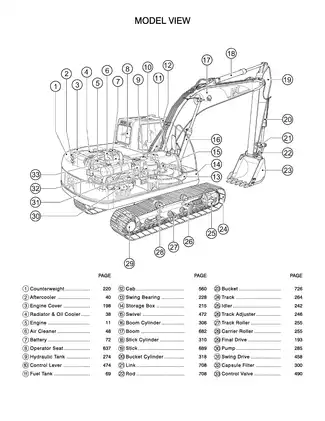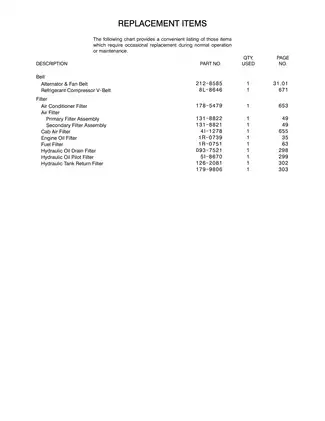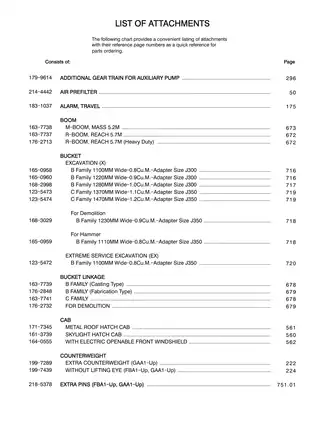Comprehensive Caterpillar 320C and 320C L Track-Type Excavator Parts Manual (Dec 2004)
Product Gallery

Sample pages from the Comprehensive Caterpillar 320C and 320C L Track-Type Excavator Parts Manual (Dec 2004) manual




Purchase Information
Caterpillar Track-Type 320C and 320CL Excavator Parts Manual - Technical Specifications
- Document Number / Seller:
- 29545 / Carol Peterson
- File Size:
- 21.47 MB
- File Type:
- Language:
- English
- Printable:
- Yes
- Estimated Download Time:
- 0.44 Minutes
- Delivery Format:
- Digital (PDF) - Instant Access
- Category:
- Bulldozer
- Brand:
- Caterpillar
- Reviewed and Approved:
- Sep 24, 2025
Caterpillar Models and Parts Covered in this Bulldozer Manual
- Caterpillar 320C
- Caterpillar 320C L
Complete Manual Information
Caterpillar Track-Type 320C and 320C L Excavator Parts Manual (Dec 2004)
Are you in need of detailed information regarding parts for your Caterpillar Track-Type Excavator? Our comprehensive service manual provides you with extensive insights into the machinery, ensuring that you have everything you need for repairs and maintenance. This parts manual covers specific models and includes illustrations coupled with a thorough parts list, making it an invaluable resource for mechanics and equipment operators alike.
What's Inside
This manual includes the following sections:
- Part Names: An alphabetical index of essential components for easy navigation.
- Illustrations: Carefully detailed graphics of parts to visually guide you through identification and assembly.
- Part Number Reference: Each illustration is accompanied by corresponding part numbers for easy ordering and maintenance.
- Maintenance Tips: Suggestions to keep your machinery in peak condition, prolonging its lifespan.
- Attachment Listings: Information on attachments and their specifications to enhance your machine's functionality.
- Serial Number Guide: Definitions of applicable serial numbers to ensure compatibility with your specific model.
Use this manual to delve into parts like the Engine, Track Components, and much more!
This manual is essential for anyone owning or operating a Caterpillar Track-Type Excavator, providing peace of mind knowing all information is backed by a detailed and methodical approach to equipment maintenance
Download Instructions for Caterpillar Bulldozer Manual
Frequently Asked Questions - Caterpillar Bulldozer Manual
What does this Caterpillar manual cover?
This comprehensive service manual covers detailed repair procedures, maintenance schedules, troubleshooting guides, and technical specifications for Comprehensive Caterpillar 320C and 320C L Track-Type Excavator Parts Manual (Dec 2004). It includes information for the following models: * Caterpillar 320C * Caterpillar 320C L.
Is this manual suitable for beginners?
Yes, this Caterpillar manual is designed for both professional technicians and DIY enthusiasts. It includes step-by-step procedures with clear illustrations and safety guidelines for Bulldozer maintenance and repair.
What file format will I receive?
You will receive this manual as a PDF file (21.47 MB), which is compatible with all devices. The manual is fully searchable and printable for your convenience.
How quickly can I access the manual after purchase?
You'll receive instant access to your Caterpillar Bulldozer manual immediately after payment completion. The download link is valid for 3 days, with lifetime re-download guarantee.
Can I print specific sections of the manual?
Absolutely! This digital manual allows you to print any section you need, from individual pages to complete chapters, making it perfect for workshop use.
Customer Reviews and Feedback
Read what our customers say about this Caterpillar Bulldozer manual and share your own experience.
Add Comment
This policy contains information about your privacy. By posting, you are declaring that you understand this policy:
- Your name, rating, website address, town, country, state and comment will be publicly displayed if entered.
- Aside from the data entered into these form fields, other stored data about your comment will include:
- Your IP address (not displayed)
- The time/date of your submission (displayed)
- Your email address will not be shared. It is collected for only two reasons:
- Administrative purposes, should a need to contact you arise.
- To inform you of new comments, should you subscribe to receive notifications.
- A cookie may be set on your computer. This is used to remember your inputs. It will expire by itself.
This policy is subject to change at any time and without notice.
These terms and conditions contain rules about posting comments. By submitting a comment, you are declaring that you agree with these rules:
- Although the administrator will attempt to moderate comments, it is impossible for every comment to have been moderated at any given time.
- You acknowledge that all comments express the views and opinions of the original author and not those of the administrator.
- You agree not to post any material which is knowingly false, obscene, hateful, threatening, harassing or invasive of a person's privacy.
- The administrator has the right to edit, move or remove any comment for any reason and without notice.
Failure to comply with these rules may result in being banned from submitting further comments.
These terms and conditions are subject to change at any time and without notice.
Comments (2)